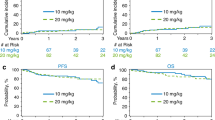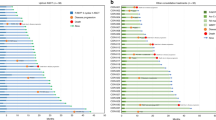Abstract
The prognosis of high-risk retinoblastoma (RB) with extraocular disease, relapse, or invasion of the cut end of the optic nerve is extremely poor. Following the discontinuation of thiotepa production in Japan, BU- and melphalan (Mel)-based regimens have been used, followed by the standard treatment for neuroblastoma. This study retrospectively analyzed 14 high-risk RB patients who underwent high-dose chemotherapy (HDC) and hematopoietic SCT; 8 received a BU/Mel conditioning regimen and 6 received other regimens. The disease status at HDC was relapse in 8 patients and extraocular involvement in 5. All patients received peripheral blood stem cell infusion >1.5 × 106/kg. Engraftment occurred within a median of 11 days (BU/Mel: 10–13, others: 9–13). Primary toxicities included mucositis (⩾grade 3) in 9 patients (4 with BU/Mel, 5 with others). Veno-occlusive disease (VOD) occurred in two 1-year-old patients in the BU/Mel group. There were no treatment-related deaths. Of 4 (2 with BU/Mel, 2 with others) patients with central nervous system (CNS) relapse after HDC, 3 died. In conclusion, the BU/Mel regimen may be feasible for high-risk RB under careful monitoring for VOD, particularly in younger patients. CNS relapse associated with a lethal prognosis occurred after all regimens; therefore, further evaluation of HDC efficacy for high-risk RB is required.
This is a preview of subscription content, access via your institution
Access options
Subscribe to this journal
Receive 12 print issues and online access
$259.00 per year
only $21.58 per issue
Buy this article
- Purchase on Springer Link
- Instant access to full article PDF
Prices may be subject to local taxes which are calculated during checkout
Similar content being viewed by others
References
Antoneli CB, Steinhorst F, de Cássia Braga Ribeiro K, Novaes PE, Chojniak MM, Arias V et al. Extraocular retinoblastoma: a 13-year experience. Cancer 2003; 98: 1292–1298.
Namouni F, Doz F, Tanguy ML, Quintana E, Michon J, Pacquement H et al. High-dose chemotherapy with carboplatin, etoposide and cyclophosphamide followed by a haematopoietic stem cell rescue in patients with high-risk retinoblastoma: a SFOP and SFGM study. Eur J Cancer 1997; 33: 2368–2375.
Kremens B, Wieland R, Reinhard H, Neubert D, Beck JD, Klingebiel T et al. High-dose chemotherapy with autologous stem cell rescue in children with retinoblastoma. Bone Marrow Transplant 2003; 31: 281–284.
Matsubara H, Makimoto A, Higa T, Kawamoto H, Sakiyama S, Hosono A et al. A multidisciplinary treatment strategy that includes high-dose chemotherapy for metastatic retinoblastoma without CNS involvement. Bone Marrow Transplant 2005; 35: 763–766.
Friedman DN, Sklar CA, Oeffinger KC, Kernan NA, Khakoo Y, Marr BP et al. Long-term medical outcomes in survivors of extra-ocular retinoblastoma: the Memorial Sloan-Kettering Cancer Center (MSKCC) experience. Pediatr Blood Cancer 2013; 60: 694–699.
Palma J, Sasso DF, Dufort G, Koop K, Sampor C, Diez B et al. Successful treatment of metastatic retinoblastoma with high-dose chemotherapy and autologous stem cell rescue in South America. Bone Marrow Transplant 2012; 47: 522–527.
Jaradat I, Mubiden R, Salem A, Abdel-Rahman F, Al-Ahmad I, Almousa A . High-dose chemotherapy followed by stem cell transplantation in the management of retinoblastoma: a systematic review. Hematol Oncol Stem Cell Ther 2012; 5: 107–117.
Berthold F, Boos J, Burdach S, Erttmann R, Henze G, Hermann J et al. Myeloablative megatherapy with autologous stem-cell rescue versus oral maintenance chemotherapy as consolidation treatment in patients with high-risk neuroblastoma: a randomised controlled trial. Lancet Oncol 2005; 6: 649–658.
Ladenstein RL, Poetschger U, Luksch R, Brock P, Castel V, Yaniv I et al. Busulphan-melphalan as a myeloablative therapy (MAT) for high-risk neuroblastoma: results from the HR-NBL1/SIOPEN trial. J Clin Oncol 2011; 29 (Suppl) abstract 2.
Matsubara H, Makimoto A, Higa T, Kawamoto H, Takayama J, Ohira M et al. Possible benefits of high-dose chemotherapy as intensive consolidation in patients with high-risk rhabdomyosarcoma who achieve complete remission with conventional chemotherapy. Pediatr Hematol Oncol 2003; 20: 201–210.
Valteau-Couanet D, Benhamou E, Vassal G, Stambouli F, Lapierre V, Couanet D et al. Consolidation with a busulfan-containing regimen followed by stem cell transplantation in infants with poor prognosis stage 4 neuroblastoma. Bone Marrow Transplant 2000; 25: 937–942.
Author information
Authors and Affiliations
Corresponding author
Ethics declarations
Competing interests
The authors declare no conflict of interest.
Rights and permissions
About this article
Cite this article
Yasui, N., Kawamoto, H., Fujiwara, M. et al. High-dose chemotherapy for high-risk retinoblastoma: clinical course and outcome of 14 cases in the National Cancer Center, Japan. Bone Marrow Transplant 50, 221–224 (2015). https://doi.org/10.1038/bmt.2014.256
Received:
Revised:
Accepted:
Published:
Issue Date:
DOI: https://doi.org/10.1038/bmt.2014.256
This article is cited by
-
Diagnosis and severity criteria for sinusoidal obstruction syndrome/veno-occlusive disease in pediatric patients: a new classification from the European society for blood and marrow transplantation
Bone Marrow Transplantation (2018)
-
Antineoplastics
Reactions Weekly (2015)



